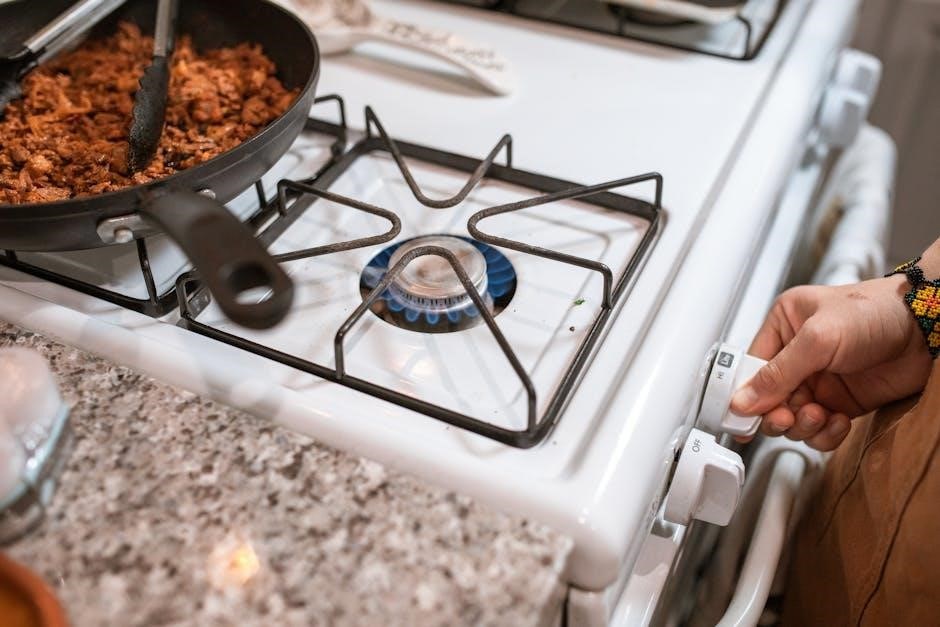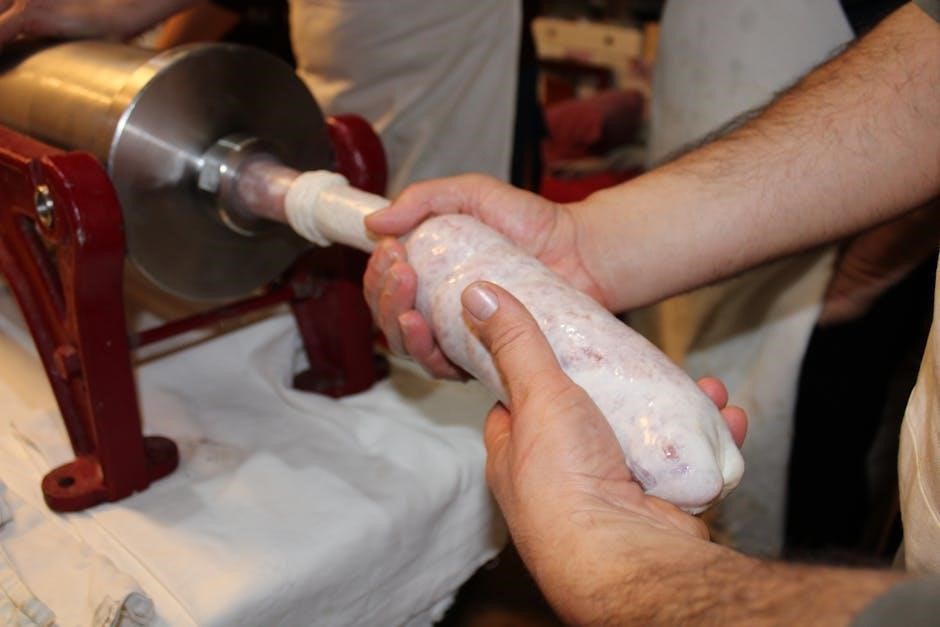Overview of Taylor Meat Thermometers
Taylor meat thermometers are essential tools for ensuring food safety and achieving perfectly cooked dishes․ They offer accurate temperature readings‚ helping users avoid undercooked or overcooked meat․ These thermometers are designed for ease of use and durability․
Types of Taylor Meat Thermometers
Taylor offers a variety of meat thermometers to suit different cooking needs․ These include digital thermometers with instant-read displays‚ ideal for quick temperature checks․ Some models feature wireless capabilities‚ allowing users to monitor the cooking progress from a distance via a smartphone app‚ such as the SMARTTHERMO app․
There are also traditional dial thermometers‚ known for their simplicity and durability․ Dual-probe thermometers are available‚ enabling simultaneous monitoring of two different dishes․ Folding thermometers‚ compact and easy to store‚ are perfect for grilling and outdoor cooking․ Each type provides reliable temperature measurement for various cooking applications․

Key Features of Taylor Meat Thermometers
Taylor meat thermometers boast features like wide temperature ranges‚ accurate readings‚ durable probe designs‚ and user-friendly interfaces․ Many include preset temperatures for different meats and auto shut-off functions for battery conservation․
Temperature Range and Accuracy
Taylor meat thermometers are designed to measure a broad spectrum of temperatures‚ typically ranging from -14°F to 572°F․ This extensive range allows users to accurately monitor the internal temperature of various foods‚ from frozen items to high-heat cooking applications․ Accuracy is a key feature‚ ensuring reliable readings for safe and precise cooking․
Achieving accurate temperature measurements is crucial for food safety and desired results․ Taylor thermometers often feature calibration options to maintain accuracy over time․ Regular checks against known temperature points can help ensure the thermometer provides consistent and trustworthy readings․ Proper usage‚ avoiding contact with bone or fat‚ also contributes to accuracy․
Furthermore‚ some models offer advanced features like digital displays with precise readings‚ minimizing guesswork․ This level of accuracy is essential for achieving the desired level of doneness in meats and other dishes‚ ensuring both safety and optimal flavor․
Probe Design and Material
The probe design of Taylor meat thermometers is crucial for accurate temperature readings and ease of use․ Probes are typically made from stainless steel‚ chosen for its durability‚ resistance to corrosion‚ and ability to withstand high temperatures․ The material ensures food safety‚ preventing any unwanted chemicals from leaching into the food during cooking․
Some models feature step-down probes‚ which have a narrower diameter (around 1․5mm) to minimize the insertion point and preserve the integrity of the food․ The probe’s length is also carefully considered‚ allowing users to reach the thickest part of the meat without difficulty․
The design often includes a pointed tip for easy insertion and a seamless connection to the thermometer body․ The overall construction ensures that the probe can be easily cleaned and maintained‚ contributing to the longevity and reliability of the thermometer․ These design elements combine to provide a safe‚ accurate‚ and user-friendly experience․

Using a Taylor Meat Thermometer
Proper use of a Taylor meat thermometer involves inserting the probe correctly into the thickest part of the meat․ Understanding preset temperatures and avoiding contact with bone ensures accuracy․
Proper Probe Placement
Achieving accurate temperature readings with a Taylor meat thermometer heavily relies on proper probe placement․ Always insert the probe into the thickest part of the meat‚ ensuring it doesn’t touch bone‚ fat‚ or gristle‚ as these can skew the results․ For roasts and larger cuts‚ aim for the center to get the most reliable internal temperature․
When cooking poultry‚ insert the probe into the thickest part of the thigh‚ avoiding the bone․ For thinner cuts‚ insert the probe horizontally from the side․ Ensure at least half the probe’s length is inside the meat for an accurate reading․ Proper placement guarantees food safety and helps you achieve the desired level of doneness‚ preventing undercooked or overcooked meals․ Always double-check the placement to ensure consistent and reliable results every time you cook․
Understanding Preset Temperatures
Taylor meat thermometers often come with preset temperature settings for various types of meat‚ simplifying the cooking process․ These presets‚ typically including options for poultry‚ beef (rare‚ medium‚ well-done)‚ pork‚ and fish‚ are designed to match recommended internal temperatures for safe and optimal cooking․ Understanding these settings is crucial for achieving consistent results and ensuring food safety․
When using a preset‚ select the appropriate meat type and desired doneness level; The thermometer will then alert you when the meat reaches the programmed temperature․ While presets are convenient‚ it’s wise to verify the accuracy using a reliable temperature chart‚ as personal preferences may vary․ Some models allow customization of preset temperatures‚ enabling you to fine-tune the cooking process to your exact liking․ Familiarizing yourself with these presets will make cooking easier․

Taylor Meat Thermometer Manuals
Taylor meat thermometer manuals provide crucial information on proper usage‚ calibration‚ and troubleshooting․ These manuals ensure users can accurately and safely cook meat to desired temperatures every time․
Finding the Correct Manual
Locating the correct manual for your Taylor meat thermometer is essential for optimal use and accurate temperature readings․ Start by identifying the model number‚ usually found on the device itself or its packaging․ Once you have the model number‚ visit the Taylor Precision Products website‚ where they store a comprehensive library of instruction manuals․
Alternatively‚ you can search online using the model number followed by “user manual” or “instruction manual․” Many online retailers and support sites also host manuals for various Taylor thermometers․ Ensure the manual matches your specific model to access relevant information on features‚ settings‚ and troubleshooting steps․ Proper manual usage ensures accurate cooking․
Troubleshooting Common Issues
Encountering issues with your Taylor meat thermometer can be frustrating‚ but many problems have simple solutions․ If the thermometer displays inaccurate readings‚ ensure the probe is correctly inserted into the thickest part of the meat‚ avoiding bone or fat․ Check the battery level‚ as low power can affect accuracy․ If the display is blank or unresponsive‚ replace the batteries immediately․
For wireless models‚ verify the connection between the probe and the receiver․ Reset the device if necessary‚ following the manual’s instructions․ If preset temperatures seem incorrect‚ consult the cooking table in the manual for recommended values․ By addressing these common issues‚ you can maintain your thermometer’s accuracy․

Care and Maintenance
Proper care and maintenance are crucial for prolonging the life of your Taylor meat thermometer․ Regular cleaning and appropriate storage will ensure accurate readings and prevent damage․ Follow these guidelines for optimal performance․
Cleaning and Storage
To maintain your Taylor meat thermometer‚ clean the probe thoroughly after each use․ Use warm‚ soapy water and a soft cloth to remove any food residue‚ ensuring no contact with harsh chemicals․ Some models‚ like the Taylor 5309295‚ may be waterproof‚ but always check the manual․
Avoid immersing the entire thermometer body in water unless specified․ Dry the probe completely before storing․ Store the thermometer in a cool‚ dry place‚ away from extreme temperatures or direct sunlight‚ to prevent damage․ For models with folding probes‚ ensure they are properly folded for compact storage․
Consider using a storage case to protect the thermometer from physical damage․ Regularly inspect the probe for any signs of wear or damage‚ and replace if necessary․ Proper cleaning and storage will ensure accurate readings and extend the lifespan of your thermometer․ Remember that batteries should be removed for long term storage․
